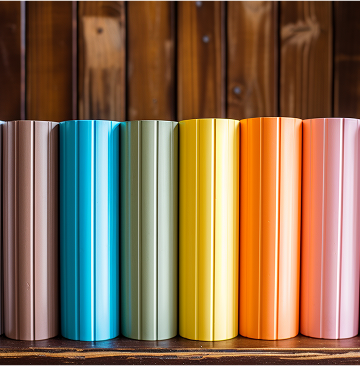Of all the FAQs we receive, the most Frequently Asked Question is about Transfer Tape: "Which tape should I use?" We have lots of articles, and a comprehensive guide to help steer you in the right direction. But as more people discover vinyl graphics and use them for different applications, like wall graphics and mugs, the envelope keeps expanding.
That means the standard answers that work for putting vinyl on glass may not work as well for you. So you need to be prepared to do some testing before you settle on a tape and vinyl solution for your application. Especially if you're going to produce high volume decals or sell them online, you need to be sure you've got the right combination of transfer tape (Otherwise known as app tape or pre mask). You might think it should be a cut-and dried, "use this; It always works". Unfortunately, it's not that simple. Here's why testing your transfer tape choice is so important.
Transferring is a Tall Order
Choosing the "right" Transfer Tape is difficult because, although it seems like a simple process, there's more to it than you might think. Here's what you're asking transfer tape to do...
- Stick to the vinyl letters so that you can pull them off the release liner.
- Then, after a few minutes, hours, days, or weeks -- depending on whether if you (or the end user is doing the installation and when that end user feels like installing it) --the tape has to let go of the letters and transfer them to the substrate.
- Then the tape must release the letters when you peel it off without pulling the letters with it-- even though the substrate may be an ideal surface like a window, or a challenging one like a porous, textured, dusty wall. Or the customer may have left the pre-masked letters in the sun or the trunk of their car and severely degraded the tape's adhesive properties.
So on one hand, you want your trusty transfer tape to stick well enough to pull the letters off the liner easily. Yet on the other hand, you want it to stick poorly enough to release those same letters easily to the substrate. You want a tape with a binary function, an on-off switch. If someone could invent a transfer tape with an electromagnetic adhesive that could be activated when you waved a wand over it, then deactivated when you waved it again, that would be perfect. Buzz...Stick! Buzz...Release! But that's not going to happen, because, once those letters are on the substrate, you're just going to throw the tape away. So you want it to be really inexpensive! Like pennies per square foot! That means that, even though we expect the application tape to have a dual personality, it has to use the least expensive adhesive possible because it's a throw-away item.
The 651 & AT60 PARABLE
It's quite a daunting task for the chemists and engineers who make the stuff. Every time they tweak the formula to improve one metric, someone cries foul because it's affected another one. R-Tape's recent experience with AT60 Clear Choice is a case in point: a parable for the industry. They made some enhancements designed to reduce static electricity and, in the process, the tack level dropped by a half a smidgen. Maybe a quarter of a smidgen, but it was still within the production tolerance levels.
Suddenly there was an outcry all across the country as people who'd been using it to transfer ORACAL 651 intermediate vinyl began to complain that it didn't work anymore. The new tape wasn't able to pull the vinyl off the liner. This caused quite a bit of head-scratching at R-Tape headquarters because it was never SUPPOSED to work with ORACAL 651, which requires a high-tack tape. Nevertheless, the customers are the reason we all do this dance, so it had to be fixed. If you're one of those customers, you already know the end of the story. R Tape couldn't get it back to the tack level that had worked before without giving up the improvement in static resistance, so they created a new version, just for the frustrated 651 users. You may not use ClearChoice or ORACAL, but it illustrates what a delicate balance it is to make a transfer tape that succeeds at the contradictory goals of being tacky enough at the beginning of the process and weak enough at the end, while also meeting targets for layflat performance, tearing, clarity, static resistance, and so on.
It's a challenging situation for tape manufacturers, especially with new untested applications coming into the market like wall graphics and decorated drinkware. So the only way to be sure a tape and vinyl combination is going to work for you is to test, test, test, and stick with the one that works. Pardon the pun. The recommendations on our Transfer Tape and Vinyl Application Guide are based on manufacturer data and our internal testing. But our test conditions may not match yours. So again, your mileage may vary. Before you commit to a tape and vinyl combination for high volume production, buy a few small rolls of different tapes and see what works best for you.



































